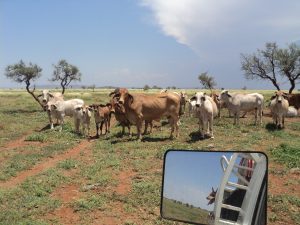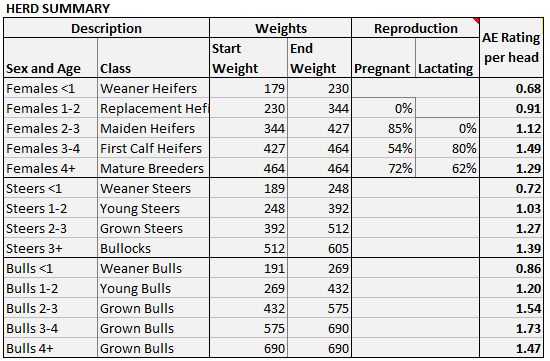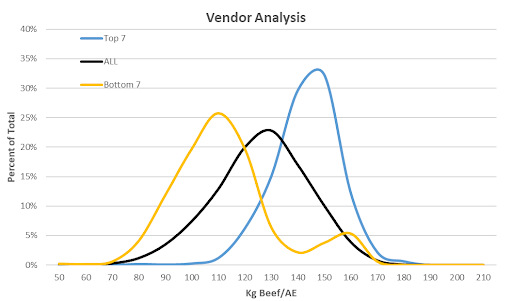Understanding and Applying Animal Units
What is an Animal Unit?
Animal units are a way of standardising animals of different classes and species so they can be expressed on a common basis. The most common animal units are an AE (Animal Equivalent) for cattle and a DSE (Dry Sheep Equivalent) for sheep.
All grazing animals (cattle, sheep, goats, kangaroo’s, horses etc.) can be expressed in animal units. Bush AgriBusiness has led work in this area to better define, understand and apply animal units in northern Australia.
Why are animal units important?
Animal Units have multiple applications; for carrying capacity assessments, property valuations, business analysis, enterprise analysis and forage budgets.
If animal units are not calculated correctly and consistently, their usefulness is limited. For example; if you want to compare a bullock operation to a weaner operation, then without animal units that accurately account for the different grazing requirements of each, the analysis is flawed.

You cannot compare them on a per head basis. Similarly, if you have the option of running sheep, cattle or goats on a property, you need to compare them using a common measure to assess them properly.
Historically animal units have been inconsistently defined and applied in northern Australia. Bush AgriBusiness has been working for many years to address this. It is important for the industry to be using a consistent, scientifically sound approach. This did not exist previously.
Much of this work has been supported by MLA (see B.NBP.0779 and B.GBP.0036) with work for QDAF further applying the work to sheep and goats. Significant additional time has been invested by us and other industry professionals to fill this important knowledge gap. It is important to us that the approach we use in our business analysis; client work, workshops, publications and other applications is sound and consistent.
By contrast, in the south, the DSE concept is well established and reasonably consistently applied.
The focus of our work was to ensure that AEs in the north were sound and based on published science, that sheep and cattle could be compared, and businesses in the north could be compared to those in the south on a like for like basis (as done in The Australian Beef Report).
What does an AE/DSE rating mean?
An animal unit rating (AE/DSE) is an animal’s energy demand relative to that of the defined standard animal. Energy demand is largely a proxy for (dry matter) intake, i.e. how much pasture they eat. Energy demand is used instead of intake as intake is inherently difficult to calculate and is influenced by diet quality. Energy Demand allows animal units to be applied and compared across regions, time, classes and species.
For example, a 300kg Hereford steer gaining 0.4kg/day will require different intakes on different pastures and at different times of the year to achieve that level of performance but its energy demand will be largely consistent. Therefore it will have the same animal unit rating, regardless of where it is located.
Intake is still a critical component in the application of animal units and is addressed below.
The animal unit rating is the average grazing load of the animal(s) over a period of time, rather than at a point in time. The AE rating is a function of what energy the animal requires for maintenance (living, eating and breathing), exercise (walking to graze and drink), liveweight growth as well as pregnancy and/or lactation if applicable.
Previous approaches have used percentage of liveweight or the metabolic weight of an animal to determine its AE rating. These, particularly the latter, are reasonable approximations of animals’ maintenance requirements but not representative of total energy demand as they don’t account for exercise or production (growth & calf) and, therefore, not representative of relative intake. As discussed above, the accuracy of the calculations influences the accuracy of the results. The
B.GBP.0036 report contains a detailed history of the development of animal units over time, as well as detailed analysis comparing the various approaches (liveweight, metabolic weight and energy demand) in northern Australia.
What are the standard animals for an AE and DSE?
The standard animal for an AE is a 450kg bos Taurus steer with zero weight gain and the DSE is a 45kg merino whether with zero weight gain. The 450kg and 45kg are derived from 1,000lb and 100lb in the old currency.
How many DSE are there to an AE, and what does this mean?
The energy demand of the defined AE is 8.4 times that of the DSE. Hence, there are 8.4 DSE to one AE. This divisor can then be used in comparing properties, enterprises or mobs. It also means that both sheep or cattle can be expressed in either AE or DSE; it is currently commonplace to express cattle in DSE units in the south.
How much does an animal unit eat?
As flagged above, this is inherently difficult to determine. Accurately measuring how much dry matter an animal consumes is not currently possible in an extensive grazing situation. A factor contributing to the time taken to resolve this intake/AE issue is that pen trials have found that the current Australian feeding standards overestimate the calculated dry matter intake for cattle grazing in northern Australia. This was addressed in the B.GBP.0036 project.
The outcome of this work is that, for northern Australia, the daily intake constant for an AE is 8.0 kilograms of dry matter. This is a default figure and can be adjusted based on productivity, reflecting the impact of diet quality.
The intake of individual animals or classes of stock is determined by multiplying the animal’s AE rating by the intake constant. For example, if the animal’s AE rating is 1.2, then its intake is 1.2 x 8.0 = 9.6 kg DM/day.
However, the intake constant can be varied to obtain better accuracy depending on the productivity of cattle in your region and property. The intake constant of 8.0 kg DM/day is used for regions of moderate productivity (where steers on average gain between 110 and 150 kg/head/year) or remains the default if productivity is unknown. If steers on your property gain on average more than 150kg/yr the intake constant is adjusted to 7.5 kg DM/AE/day. If steers gain less than 110kg/year, the intake constant is adjusted to 8.5kg DM/AE/day.
It is important to note that, because steers on the higher quality pastures gain more weight, they will consume more per head over a year (see below table). What the above intake constants reflect is that animals on poorer quality pastures need to consume more to get the same amount of energy as
an animal on a better-quality pasture would need.
Turning our attention to DSE, this equates to an intake constant of 0.95 kg DM/DSE/day for regions of moderate productivity, or 0.89 and 1.01 for higher and lower productivity regions respectively.
These intake constants apply only to tropical and sub-tropical pastures in northern Australia with the intake constant for southern Australia, derived directly from the feeding standards (NRDR 2007), being 9.4 Kg DM/AE/day and 1.12 Kg DM/DSE/day. This raises the question of where the cutoff is for north and south, which is about as easy as trying to define where the outback starts!
To keep it simple, we broadly define all of QLD, all of NT and the top half of WA as north and the remainder as south but users can apply their own judgement (i.e applying the northern estimates to the northern rangelands of SA would be more appropriate than the southern estimates).
How do you apply Animal Units?
The application of AE’s can be very simple or quite detailed, it depends on the user and their application.
For most breeding operations in the north, a standard AE rating for each class of cattle can be applied based on their regional productivity. The tables below were derived by applying the AE process to detailed growth path data from northern Australia. The AE ratings are applied to an animal on an annual basis (from anniversary of birth to anniversary of birth, e.g. 12-24mths), based on different production levels.
The production level in your situation is determined by the annual liveweight gain of your steers, as per those detailed for the AE intake constants above.
First, select a production level (if unsure apply Moderate) then identify the annual AE rating for each class of cattle from the table below.
| Productivity | |||
| Females <1# | |||
| Females 1-2 | |||
| Females 2-3 | |||
| Females 3-4 | |||
| Females 4+ | |||
| Steers <1# | |||
| Steers 1-2 | |||
| Steers 2-3 | |||
| Steers 3-4 | |||
| Grown Bulls | |||
| Intake/AE | |||
#Is from weaning to 12 months of age *includes pregnancy, lactation and calf to weaning and accounts for reproductive rate (i.e. is average of all females in age group) |
|||
These AE ratings can then be used to estimate approximate annual dry matter intakes by class by multiplying the AE rating by the relevant intake constant per AE, this is detailed in the Cattle AE and Intake Tables (by age).
Tables proving generic animal unit ratings by age have been developed for sheep and goats, expressed in Animal Equivalents or Dry Sheep Equivalents.
There are also single pages expressing the animal units ratings for cattle, sheep, goats, horses and roos in either Animal Equivalents or Dry Sheep Equivalents.
The standard tables will be reasonable approximations for most extensive herds. However, if you have reasonable production data, you may want to calculate more accurate AE ratings for your herd’s genotype and performance. You can do this using our AE Herd Tool. The table below is an example of the output of the herd tool.
These tables and tools are designed for breeding businesses, including growing progeny, and primarily provide annual AE ratings.
For a growing or trading enterprise, or to account for shorter periods, it may be more appropriate to determine AE ratings for varying production levels.
For this, we have provided a series of lookup tables (by breed type) where AE ratings of growing cattle and breeding cattle are specified for a particular level of production.
An example of these tables is shown below for crossbred cattle. Looking at the growing animal table at top left first, a crossbred steer that averages 350kg and an average daily growth of 0.4 (over a day, a month or a year) has an AE rating of 1.13. The AE ratings provided apply to either steers or dry empty females, there is additional percentage figures to apply to bulls.
The breeding females table at top right provides an annualised mob average breeding female AE rating based on the corresponding weight and mob weaning percentage.
The breeding females table at the bottom provides an AE rating for an individual female for each month of the reproductive cycle, based on her average liveweight.
There are a series of tables available to download
We have also used the animal unit methodology to apply retrospective analysis of individual animal data.
One example of this is given below, where individual animal productivity (kilograms of beef produced per AE per year) was calculated for a bullock operation. This data was then analysed by vendor; identifying and removing the worst performing vendors lifted mob average productivity by
nearly 2%.
Analysis such as this can be performed as a service by Bush AgriBusiness. We also have sheep tools available for clients on request.

Acknowledgements
The MLA and QDAF funding of the above projects to advance this work is acknowledged. Beyond the funded research, there has also been a considerable contribution of tenacity, intellect and time from Col Paton, Stu McLennan, Shane Blakeley and Ian McLean in addressing this industry issue. Nigel Tomkins and Geoff Niethe from MLA also made significant contributions.
